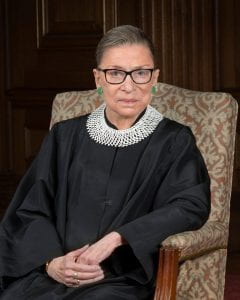By Emma Diamond
Ruth Bader Ginsburg served on the United State’s Supreme Court from 1993, when she was appointed by President Clinton, until her death in 2020. Ginsburg spent much of her life and career advocating for gender equality in America. Her impact and lasting legacy on the United States is immense.
Ruth Bader Ginsburg was born in 1933 in Brooklyn, New York. Her father, Nathan Bader, was a Jewish immigrant from Ukraine and her mother, Cecelia Bader, was born in New York to Polish immigrant parents. Because Ginsburg’s mother was forced to work instead of continuing her education after high school, she valued Ruth’s education very much. In addition, Cecelia often told Ruth that she should always be able to support herself even if she got married. Although Cecelia passed away of cancer before Ruth graduated high school, she had an extensive impact on Ruth’s life, teaching her the importance of education and independence.
After graduating from James Madison High School, Ginsburg went to college at Cornell University. Ruth met her husband, Martin Ginsburg, during her years at Cornell. Ruth said that she was drawn to Martin because he was the first boy she ever met that valued her intelligence, not only her physical appearance. Ruth graduated from Cornell in 1954 at the top of her class. Shortly after Martin was drafted into the military later that year, Ruth had her first child, Jane Ginsburg. In 1956, Ruth and Martin both enrolled in Harvard Law School. Ruth was one of nine women in a class of 500. She was often a victim of gender discrimination. She was not asked questions on the spot because professors assumed it would be too nerve wracking for a woman and she was often scolded by the dean who argued that she was taking the place of a man who deserved to be there in her place. Already dealing with the work of law school and caring for her daughter, Ginsburg had to take on even more responsibility. In his third year at Harvard, Martin was diagnosed with testicular cancer. Ruth did both her and her husband’s work for school. After Martin beat his cancer, he got a job in New York City. Because she wanted to keep her family together, Ruth transferred to Columbia University. She graduated, again at the top of her class, in 1959.
Because she was a woman, Ruth Bader Ginsburg had a very difficult time finding a job in law. She was continuously declined because of her gender. Eventually, she became a law professor at Rutgers Law School and taught there for nine years. After her time at Rutgers, Ginsburg co-founded the Women’s Rights Project at the American Civil Liberties Union in 1972. Two years later, the project had taken part in more than 300 cases about gender discrimination. Ginsburg believed that the most effective way to advocate for gender equality was to not try to address everything at once, but to take many small strides. While part of the Women’s Rights Project at the ACLU, Ginsburg appeared before the Supreme Court as a lawyer for six cases. Ginsburg not only took cases in which women were discriminated against, but in order to ensure the justices related to the issue, she also took cases in which men were discriminated against. However, Ginsburg argued that every case that only seemed to involve discrimination against men on the surface, was deeply rooted in discrimination against women. For example, in 1975, Ginsberged worked on Weinberger vs. Wiesenfeld. In this case, a widower was not allowed to collect social security benefits while caring for children because of a law that enabled widows, but not widowers to collect these benefits. On the surface, this law discriminated against men because they were not allowed to gain the same benefits as women. However, when you look at this law more closely, it assumes that men are the sole providers for households and it does not value the work of women. Ginsburg worked to point out these deeper implications throughout her work.
After her work with the Women’s Rights Project, Ginsburg was nominated to be a judge for the DC Court of Appeals by President Jimmy Carter in 1980. While serving on this court, Ginsburg was considered a moderate. After serving thirteen years on the Court of Appeals, in 1993, President Bill Clinton appointed Ginsburg for the United States Supreme Court. Ginsburg became the second woman on the Supreme Court. Throughout her years on the court, Ginsburg became more and more liberal. She continued her advocacy for gender equality and other pressing issues through her many dissenting opinions. Ruth Bader Ginsburg’s pioneering work for women’s rights will have a lasting impact on the United States.
Sources:
https://www.history.com/topics/womens-history/ruth-bader-ginsburg
“RBG” (2018) – documentary about RBG’s life and career

